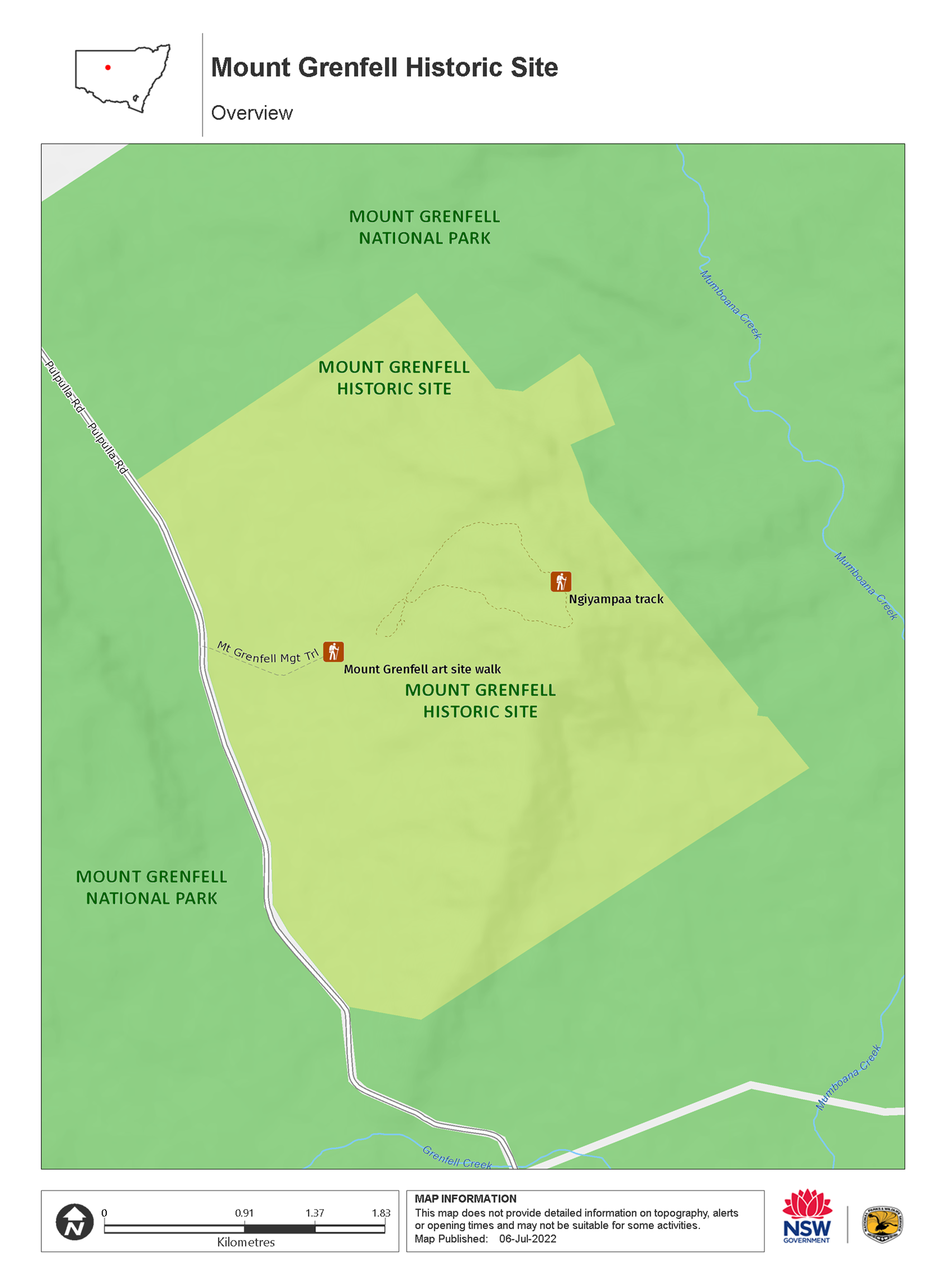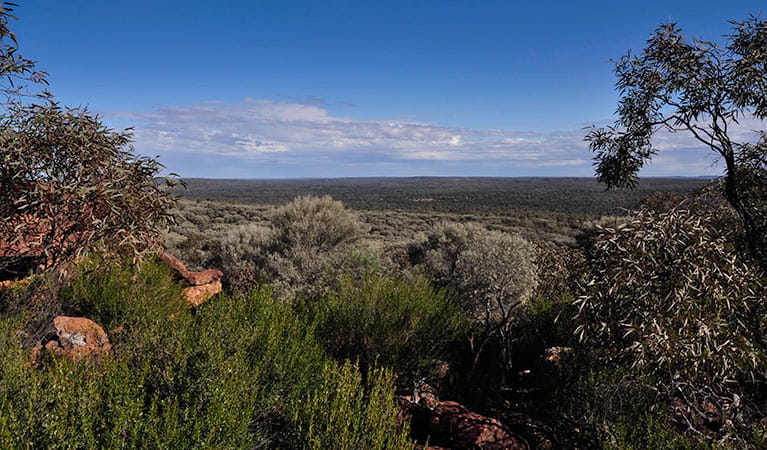Mount Grenfell Historic Site
Overview
Mount Grenfell Historic Site in Cubba protects Ngiyampaa rock art. It’s a short walk to this important Aboriginal site, and a more challenging one to a scenic lookout.
Read more about Mount Grenfell Historic Site
For thousands of years before Europeans settled in this part of NSW, Ngiyampaa people regularly gathered around the semi-permanent waterhole and took shelter in the overhangs of what is now Mount Grenfell Historic Site. In the surrounding rocky ridge, you can see richly coloured paintings of human and animal figures, representations of the natural environment, and hand stencils which are of ceremonial significance to traditional owners.
Nowadays, this extensive Aboriginal rock art is protected within the park and can be reached following the short, easy Mount Grenfell art site walk. Another more challenging hiking trail, Ngiyambaa walking track, takes you further into this gorgeous landscape of red dirt, mallee bushland, open grasslands and the rocky rise of Mount Grenfell itself. The scenic view from the summit, across this low-relief plain, is vast and wide.
Bring the family and a picnic lunch, and take your time in this special place to enjoy the surroundings and learn more about Ngiyampaa culture and heritage.
Local alerts
For the latest updates on fires, closures and other alerts in this area, see https://www.nationalparks.nsw.gov.au/visit-a-park/parks/mount-grenfell-historic-site/local-alerts
Contact
- in the Outback NSW region
Mount Grenfell Historic Site is always open but may have to close at times due to poor weather, fire danger or cultural activities.
-
-
Dubbo office
02 6841 7100
Contact hours: Monday to Friday, 8.30am to 4.30pm. - 74 River Street, Dubbo, NSW 2830
-
Email: npws.centralwest@environment.nsw.gov.au
-
Dubbo office
Visitor info
All the practical information you need to know about Mount Grenfell Historic Site.
Map

Map legend

Maps and downloads
Nearby towns
Cobar (70 km)
Cobar is a flourishing town built around the thriving mining and pastoral industries. Mining commenced here in the 1870s, and today, the town is an important source of copper, lead, silver, zinc and gold. Find out about Cobar's rich past at the Great Cobar Heritage Centre.
Tilpa (160 km)
There are plenty of things to see and do in the great outdoors around Tilpa. Birdwatching during the migratory season is popular, and enjoying a peaceful picnic by a quiet waterhole along the Darling River is a pure outback experience.
Bourke (230 km)
Around 50km north of Gundabooka National Park is the town of Bourke. Considered the "Gateway to the real outback", Bourke is home to around 3,000 people and has a range of places to eat, garages and services, and plenty of things to do.
Learn more
Mount Grenfell Historic Site is a special place. Here are just some of the reasons why:
Making a scene

At Mount Grenfell, art featuring all facets of Aboriginal life covers rocky overhangs surrounding the park’s waterhole. Many are linear paintings done by applying wet pigment with a fingertip or natural brush. Others are hand stencils. In some places, ochre and white pipeclay have been applied thickly and left to dry. More recent paintings have been superimposed over older ones. There are stick figures, human figures, images of birds and animals, medicine, food, the landscape and dreaming stories. This art remains deeply significant to Ngiyampaa people.
Ngiyampaa: Past, present and future

The Ngiyampaa (pronounced nee-yam-par) are dryland people associated with the arid plains and rocky hill country of Central West NSW bordered roughly by Lachlan, Darling-Barwon and Bogan Rivers. The semi-permanent waterhole at Mount Grenfell was an important meeting place for generation after generation of this Aboriginal group. Following European settlement, however, Ngiyampaa people were moved to stations northwest of Wiradjuri country and in the 1930s, many were relocated again to Murrin Bridge near Lake Cargelligo. On 17 July 2004, Mount Grenfell was handed back to traditional owners and is now jointly managed with NSW NPWS. Ngiyampaa people maintain strong connections with this area and continue to pass on cultural knowledge.
Living off the land

Emus and kangaroos inhabit Mount Grenfell and, on warmer days, you’re likely to see bearded dragons, shinglebacks and geckos. Keep a careful eye out too for endangered kultarr (also known as jerboa pouched-mouse, wuhl-wuhl or pitchi-pitchi), which can best be described as a mouse that hops. While you’re looking down for a pitchi-pitchi, you may also see a red-capped robin rifling through the leaf litter. This bird is often part of a mixed species feeding flock with other similarly sized birds such as thornbills, which also inhabit the park.
Education resources (1)
What we're doing
Mount Grenfell Historic Site has management strategies in place to protect and conserve the values of this park. View the detailed park and fire management documents.
General enquiries
- National Parks Contact Centre
- 7am to 7pm daily
- 1300 072 757 (13000 PARKS) for the cost of a local call within Australia excluding mobiles
- parks.info@environment.nsw.gov.au
Contact
- in the Outback NSW region
Mount Grenfell Historic Site is always open but may have to close at times due to poor weather, fire danger or cultural activities.
-
-
Dubbo office
02 6841 7100
Contact hours: Monday to Friday, 8.30am to 4.30pm. - 74 River Street, Dubbo, NSW 2830
-
Email: npws.centralwest@environment.nsw.gov.au
-
Dubbo office

